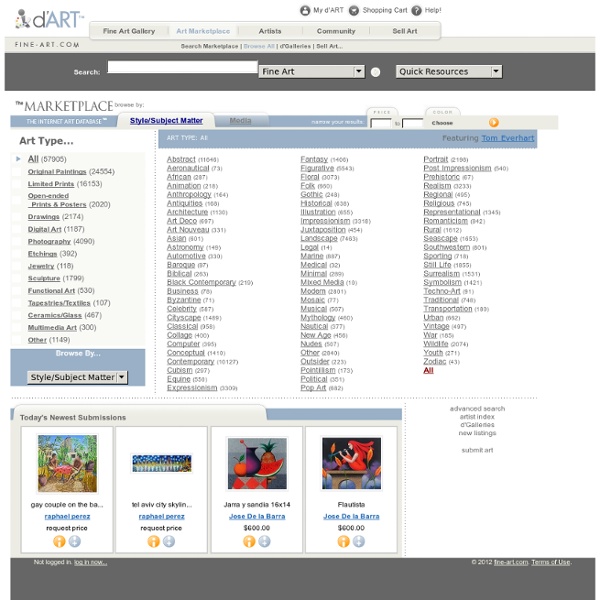



Further Collective - Home Art as Therapy: Alain de Botton on the 7 Psychological Functions of Art by Maria Popova “Art holds out the promise of inner wholeness.” The question of what art is has occupied humanity since the dawn of recorded history. For Tolstoy, the purpose of art was to provide a bridge of empathy between us and others, and for Anaïs Nin, a way to exorcise our emotional excess. But the highest achievement of art might be something that reconciles the two: a channel of empathy into our own psychology that lets us both exorcise and better understand our emotions — in other words, a form of therapy. In Art as Therapy (public library), philosopher Alain de Botton — who has previously examined such diverse and provocative subjects as why work doesn’t work, what education and the arts can learn from religion, and how to think more about sex — teams up with art historian John Armstrong to examine art’s most intimate purpose: its ability to mediate our psychological shortcomings and assuage our anxieties about imperfection. But these worries, they argue, are misguided.
Fine art Fine art, from the 17th century on, has meant art forms developed primarily for aesthetics, distinguishing them from applied arts that also have to serve some practical function. Historically, the 5 main fine arts were painting, sculpture, architecture, music and poetry, with performing arts including theater and dance.[1] Today, the fine arts commonly include additional forms, such as film, photography, conceptual art, and printmaking. However, in some institutes of learning or in museums, fine art and frequently the term fine arts (pl.) as well, are associated exclusively with visual art forms.[citation needed] The word "fine" does not so much denote the quality of the artwork in question, but the purity of the discipline. History[edit] According to some writers the concept of a distinct category of fine art is an invention of the early modern period in the West. Cultural perspectives[edit] Two-dimensional work[edit] Painting and Drawing[edit] Mosaics[edit] Printmaking[edit] Calligraphy[edit]
Korean Artist Transforms Her Small Studio Into Dreamlike Worlds Without Photoshop EmailEmail Korean artist Jee Young Lee’s beautiful dreamscapes are living proof that you don’t need Photoshop or even a large studio space to create amazing surreal images. She creates all of these scenes by hand in a room that is only 3.6 x 4.1 x 2.4 meters and then inserts herself into the pictures. Some of these self portraits represent her own experiences, dreams and memories, while others represent traditional Korean folk tales and legends. Source: opiomgallery.com
Insecula.com Incredible paintings of sci-fi suburbia will make you wish you were Swedish Welcome to rural Sweden, sometime in the late '80s. Citizens go about their mundane lives and children explore the countryside. But something isn't quite right. This is the world that exists in artist Simon Stålenhag's mind, and it's only accessible through his paintings. The artwork is impactful as a result of this juxtaposition between the harsh realities of life and the sci-fi technologies of our dreams. Simon Stålenhag used a Wacom tablet and pen to digitally paint the works below.
Ministère de la culture - Direction des musées de France - Base Joconde BOUDIN Eugène, Venise, La douane et Notre-Dame-de-la-Salute, huile sur bois, 1895, Reims, musée des beaux-arts © Christian Devleeschauwer1/28 Costume de China Poblana, Mexique, coton, laine, sequin, perle de verre, 4e quart 19e siècle, 1er quart 20e siècle, Barcelonnette, musée de la Vallée, © BERNARD Jean2/28 MAISON J ROTHSCHILD & Fils et RHEIMS & AUSCHER, Modèle de landau à huit ressorts, crayon graphite sur papier bristol, 4e quart 19e siècle - 20e siècle, Compiègne, musée national de la voiture et du tourisme © Arkhênum ; Compiègne, musée national de la voiture et du tourisme - utilisation soumise à autorisation3/28 Portrait de Tiberius Gemellus ? DE DIETRICH, Saint Georges terrassant le dragon, bas-relief, fonte moulée, entre 1950 et 1960, Reichshoffen, musée historique et industriel, musée du fer © Pommois Etienne28/28
What Happens When You Zap Instant Film With 15,000 Volts | Wired Design Phillip Stearns is an artist who sees beauty where others see computer bugs. Phillip Stearns He collects images of artful computer abnormalities on his blog and has transformed images from fried cameras into tasteful home furnishings, but for his latest project called High Voltage, Stearns is experimenting with electricity and chemistry. Each image in this series is created by zapping Fujifilm instant color film with electricity produced by a transformer used to power neon signs. Stearns' process isn't exposing the film per se. The light from the sparks accounts for some of the bluish colors in the background of the shots, but the electrical "tree" structures, technically called Lichtenberg figures, are created when the electricity vaporizes the silver halides embedded in the film. He adds to the image by pouring liquids—bleach, vinegar, hydrogen peroxide, rubbing alcohol—onto the film and arcing electricity through them which which adds chemical coloration. "Plasma.
UbuWeb An Incredible Fantasy World Mapped With Google Street View | Raw File Unorthodox Aaron Hobson Iceland Italian Drop-off Civitanova del Sannio Las Champas New York, Ireland La Línea de la Concepción South Africa Falls Middle Earth Spanish Floods Occurence Above Rio Verde Bridge Otuzco Bugarach From German forests to the French Pyrenees, from the Rock of Gibraltar to Iceland’s tundra, artist Aaron Hobson spends endless hours traversing continents looking for eye-catching scenes. There are plenty of GSV photo projects out there, but Hobson’s heavily ‘shopped Cinemascapes are a refreshing departure from the usual documentary reality. “GSV is a fantasy world,” says Hobson. Hobson estimates that 95% of his time on GSV yields nothing of interest, but an accidental benefit is an increased geographical knowledge. “Patience is key. Once he’s got a shot he likes, it’s time to add some fantasy. Hobson came to surfing GSV when he was location scouting for a movie to be directed in Los Angeles. All images: Aaron Hobson It’s just about mad enough, it might be genius.